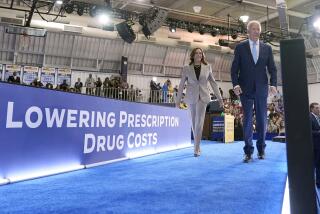Waxman Blasts Cost of Prescription Drugs : Health: Lawmaker cites GAO study that found U.S. manufacturers charging considerably more than Canadian counterparts.
- Share via
WASHINGTON — U.S. drug manufacturers charge an average of 32% more for prescription drugs than their counterparts in neighboring Canada, according to a study released Wednesday by Rep. Henry A. Waxman (D-Los Angeles).
The study, conducted at Waxman’s request by the General Accounting Office, the congressional watchdog agency, said that at least half of the drugs studied cost wholesalers 50% more in the United States and that 27 of the best-selling 200 drugs cost wholesalers at least twice as much here as in Canada.
“Once again, the United States is behind the rest of the world in providing health care to our people,” Waxman said. “Canada has found ways to control prescription drug prices. So have most other countries. It’s time for the United States to get on the bandwagon.”
The escalating cost of prescription drugs has become a hotly discussed topic in the debate over reforming the health care system and is certain to emerge as an even larger issue in coming months if Arkansas Gov. Bill Clinton is elected President. Clinton has pledged to curb the rising costs of drugs by ending special tax breaks for pharmaceutical companies that raise drug prices faster than inflation.
Officials from the Pharmaceutical Manufacturers Assn., which represents the prescription drug industry, called the study misleading.
“As the report itself admits,” the association said in a statement, “it compares ‘sticker’ prices of U.S. products with the lowest prices available in Canada. By weakening patent protection of pharmaceuticals, Canada has produced artificially low prices. . . . “
“The cost has been to stifle innovation by the Canadian pharmaceutical industry, which has produced virtually no important products since the . . . system was established in 1969.”
Industry officials have long defended their pricing decisions as necessary to stay on the cutting edge of science--saying that the cost of drugs reflects the funds that they invest in the research and development of new drugs.
Waxman dismissed the argument, saying: “The companies always justify high prices by arguing that profits are the best stimulus to research on breakthrough drugs. That may be true, but we have to ask the question of whether prices in this country go way beyond what is necessary to stimulate research.
“It appears that our citizens are bearing a disproportionate portion of the burden of drug research, while other countries get both the benefits of the research and significantly lower prices,” he added.
The GAO attributed price differences between the United States and Canada to several factors, including greater government regulation of drug prices. Canadian rules restrain introductory costs for both new patented drugs and increases for existing patented drugs. Also, drug benefit plans, among other things, do not cover certain drugs if proposed price increases are considered too great.
The report said that four of the top 10 selling prescription drugs in the United States cost between 59% and 278% more in this country than in Canada. The drugs are Synthroid, a thyroid therapy (278%); Xanax, a tranquilizer (183%); Premarin, which treats the symptoms of menopause (162%), and Ceclor, an antibiotic (59%).
The study cautioned, however, that “the debate over the linkage of drug prices to innovation in the United States cannot be resolved solely by referring to the Canadian experience with drug price regulation.”
Canada represents a small share of the world market, while the United States consumes 13 times as much as the Canadian market, the report said.
“Regulations that reduced drug prices in the United States would have a much more adverse effect on manufacturers’ revenues than would similar regulation in Canada,” the report added.
More to Read
Sign up for Essential California
The most important California stories and recommendations in your inbox every morning.
You may occasionally receive promotional content from the Los Angeles Times.













